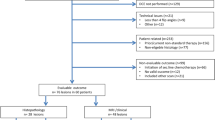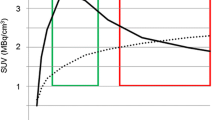Abstract
Purpose
Positron emission tomography (PET) using O-(2-[18F]fluoroethyl)-L-tyrosine ([18F]FET) improves the diagnostics of cerebral gliomas compared with conventional magnetic resonance imaging (MRI). Sodium MRI is an evolving method to assess tumor metabolism. In this pilot study, we explored the relationship of [18F]FET-PET and sodium MRI in patients with cerebral gliomas in relation to the mutational status of the enzyme isocitrate dehydrogenase (IDH).
Procedures
Ten patients with untreated cerebral gliomas and one patient with a recurrent glioblastoma (GBM) were investigated by dynamic [18F]FET-PET and sodium MRI using an enhanced simultaneous single-quantum- and triple-quantum-filtered imaging of 23Na (SISTINA) sequence to estimate total (NaT), weighted non-restricted (NaNR, mainly extracellular), and restricted (NaR, mainly intracellular) sodium in tumors and normal brain tissue. [18F]FET uptake and sodium parameters in tumors with a different IDH mutational status were compared. After biopsy or resection, histology and the IDH mutational status were determined neuropathologically.
Results
NaT (p = 0.05), tumor-to-brain ratios (TBR) of NaT (p = 0.02), NaNR (p = 0.003), and the ratio of NaT/NaR (p < 0.001) were significantly higher in IDH-mutated than in IDH-wild-type gliomas (n = 5 patients each) while NaR was significantly lower in IDH-mutated gliomas (p = 0.01). [18F]FET parameters (TBR, time-to-peak) were not predictive of IDH status in this small cohort of patients. There was no obvious relationship between sodium distribution and [18F]FET uptake. The patient with a recurrent GBM exhibited an additional radiation injury with strong abnormalities in sodium MRI.
Conclusions
Sodium MRI appears to be more strongly related to the IDH mutational status than are [18F]FET-PET parameters. A further evaluation of the combination of the two methods in a larger group of high- and low-grade gliomas seems promising.




Similar content being viewed by others
References
Ostrom QT, Gittleman H, Liao P et al (2014) CBTRUS statistical report: primary brain and central nervous system tumors diagnosed in the United States in 2007-2011. Neuro Oncol 16(Suppl 4):iv1–i63
Ohgaki H, Kleihues P (2005) Population-based studies on incidence, survival rates, and genetic alterations in astrocytic and oligodendroglial gliomas. J Neuropathol Exp Neurol 64:479–489
Louis DN, Perry A, Reifenberger G, von Deimling A, Figarella-Branger D, Cavenee WK, Ohgaki H, Wiestler OD, Kleihues P, Ellison DW (2016) The 2016 World Health Organization Classification of Tumors of the Central Nervous System: a summary. Acta Neuropathol 131:803–820
Langen KJ, Galldiks N, Hattingen E, Shah NJ (2017) Advances in neuro-oncology imaging. Nat Rev Neurol 13:279–289
Leu K, Ott GA, Lai A, Nghiemphu PL, Pope WB, Yong WH, Liau LM, Cloughesy TF, Ellingson BM (2017) Perfusion and diffusion MRI signatures in histologic and genetic subtypes of WHO grade II-III diffuse gliomas. J Neuro-Oncol 134:177–188
Xing Z, Yang X, She D, Lin Y, Zhang Y, Cao D (2017) Noninvasive assessment of IDH mutational status in World Health Organization grade II and III astrocytomas using DWI and DSC-PWI combined with conventional MR imaging. AJNR Am J Neuroradiol 38:1138–1144
Kunz M, Albert NL, Unterrainer M et al (2018) Dynamic 18F-FET PET is a powerful imaging biomarker in gadolinium-negative gliomas. Neuro-Oncology
Suchorska B, Giese A, Biczok A, Unterrainer M, Weller M, Drexler M, Bartenstein P, Schüller U, Tonn JC, Albert NL (2018) Identification of time-to-peak on dynamic 18F-FET-PET as a prognostic marker specifically in IDH1/2 mutant diffuse astrocytoma. Neuro-Oncology 20:279–288
Verger A, Stoffels G, Bauer EK, Lohmann P, Blau T, Fink GR, Neumaier B, Shah NJ, Langen KJ, Galldiks N (2018) Static and dynamic 18F-FET PET for the characterization of gliomas defined by IDH and 1p/19q status. Eur J Nucl Med Mol Imaging 45:443–451
Unterrainer M, Winkelmann I, Suchorska B, Giese A, Wenter V, Kreth FW, Herms J, Bartenstein P, Tonn JC, Albert NL (2018) Biological tumour volumes of gliomas in early and standard 20-40 min 18F-FET PET images differ according to IDH mutation status. Eur J Nucl Med Mol Imaging 45:1242–1249
Rohrich M, Huang K, Schrimpf D et al (2018) Integrated analysis of dynamic FET PET/CT parameters, histology, and methylation profiling of 44 gliomas. Eur J Nucl Med Mol Imaging 45:1573–1584
Lopci E, Riva M, Olivari L, Raneri F, Soffietti R, Piccardo A, Bizzi A, Navarria P, Ascolese AM, Rudà R, Fernandes B, Pessina F, Grimaldi M, Simonelli M, Rossi M, Alfieri T, Zucali PA, Scorsetti M, Bello L, Chiti A (2017) Prognostic value of molecular and imaging biomarkers in patients with supratentorial glioma. Eur J Nucl Med Mol Imaging 44:1155–1164
Madelin G, Regatte RR (2013) Biomedical applications of sodium MRI in vivo. J Magn Reson Imaging 38:511–529
Shah NJ, Worthoff WA, Langen KJ (2016) Imaging of sodium in the brain: a brief review. NMR Biomed 29:162–174
Murphy E, Eisner DA (2009) Regulation of intracellular and mitochondrial sodium in health and disease. Circ Res 104:292–303
Thulborn KR, Lu A, Atkinson IC, Damen F, Villano JL (2009) Quantitative sodium MR imaging and sodium bioscales for the management of brain tumors. Neuroimaging Clin N Am 19:615–624
Ouwerkerk R, Bleich KB, Gillen JS, Pomper MG, Bottomley PA (2003) Tissue sodium concentration in human brain tumors as measured with 23Na MR imaging. Radiology 227:529–537
Nagel AM, Bock M, Hartmann C, Gerigk L, Neumann JO, Weber MA, Bendszus M, Radbruch A, Wick W, Schlemmer HP, Semmler W, Biller A (2011) The potential of relaxation-weighted sodium magnetic resonance imaging as demonstrated on brain tumors. Investig Radiol 46:539–547
Fiege DP, Romanzetti S, Mirkes CC, Brenner D, Shah NJ (2013) Simultaneous single-quantum and triple-quantum-filtered MRI of 23Na (SISTINA). Magn Reson Med 69:1691–1696
Worthoff WA, Shymanskaya A, Shah NJ (2019) Relaxometry and quantification in simultaneously acquired single and triple quantum filtered sodium MRI. Magn Reson Med 81:303–315
Jaccard G, Wimperis S, Bodenhausen G (1986) Multiple-quantum Nmr-spectroscopy of S=3/2 spins in isotropic-phase - a new probe for multiexponential relaxation. J Chem Phys 85:6282–6293
Keltner JR, Wong ST, Roos MS (1994) Three-dimensional triple-quantum-filtered imaging of 0.012 and 0.024 M sodium-23 using short repetition times. J Magn Reson B 104:219–229
Woessner DE (2001) NMR relaxation of spin-(3)/(2) nuclei: effects of structure, order, and dynamics in aqueous heterogeneous systems. Concept Magn Res 13:294–325
Babsky AM, Zhang H, Hekmatyar SK, Hutchins GD, Bansal N (2007) Monitoring chemotherapeutic response in RIF-1 tumors by single-quantum and triple-quantum-filtered 23Na MRI, (1)H diffusion-weighted MRI and PET imaging. Magn Reson Imaging 25:1015–1023
Biller A, Badde S, Nagel A, Neumann JO, Wick W, Hertenstein A, Bendszus M, Sahm F, Benkhedah N, Kleesiek J (2016) Improved brain tumor classification by sodium MR imaging: prediction of IDH mutation status and tumor progression. AJNR Am J Neuroradiol 37:66–73
Hamacher K, Coenen HH (2002) Efficient routine production of the 18F-labelled amino acid O-2-18F fluoroethyl-L-tyrosine. Appl Radiat Isot 57:853–856
Wester HJ, Herz M, Weber W, Heiss P, Senekowitsch-Schmidtke R, Schwaiger M, Stöcklin G (1999) Synthesis and radiopharmacology of O-(2-[18F]fluoroethyl)-L-tyrosine for tumor imaging. J Nucl Med 40:205–212
Langen KJ, Bartenstein P, Boecker H, Brust P, Coenen HH, Drzezga A, Grünwald F, Krause BJ, Kuwert T, Sabri O, Tatsch K, Weber WA, Schreckenberger M (2011) German guidelines for brain tumour imaging by PET and SPECT using labelled amino acids. Nuklearmedizin 50:167–173
Herzog H, Tellmann L, Hocke C, Pietrzyk U, Casey ME, Kuwert T (2004) NEMA NU2-2001 guided performance evaluation of four siemens ECAT PET scanners. IEEE Trans Nucl Sci 51:2662–2669
Unterrainer M, Vettermann F, Brendel M, Holzgreve A, Lifschitz M, Zähringer M, Suchorska B, Wenter V, Illigens BM, Bartenstein P, Albert NL (2017) Towards standardization of 18F-FET PET imaging: do we need a consistent method of background activity assessment? EJNMMI Res 7:48
Pauleit D, Floeth F, Hamacher K et al (2005) O-(2-[18F]fluoroethyl)-L-tyrosine PET combined with MRI improves the diagnostic assessment of cerebral gliomas. Brain 128:678–687
Fiege DP, Romanzetti S, Tse DH et al (2013) B0 insensitive multiple-quantum resolved sodium imaging using a phase-rotation scheme. J Magn Reson 228:32–36
Worthoff WA, Shymanskaya A, Shah NJ (2018) Relaxometry and quantification in simultaneously acquired single and triple quantum filtered sodium MRI. Magn Reson Med Sci in press
Woolrich MW, Jbabdi S, Patenaude B, Chappell M, Makni S, Behrens T, Beckmann C, Jenkinson M, Smith SM (2009) Bayesian analysis of neuroimaging data in FSL. Neuroimage 45:S173–S186
Smith SM, Jenkinson M, Woolrich MW, Beckmann CF, Behrens TEJ, Johansen-Berg H, Bannister PR, de Luca M, Drobnjak I, Flitney DE, Niazy RK, Saunders J, Vickers J, Zhang Y, de Stefano N, Brady JM, Matthews PM (2004) Advances in functional and structural MR image analysis and implementation as FSL. Neuroimage 23(Suppl 1):S208–S219
Jenkinson M, Beckmann CF, Behrens TE et al (2012) Fsl. Neuroimage 62:782–790
Kaufman PL, Adler FH, Levin LA, Alm A (2011) Adler’s physiology of the eye. Elsevier Health Sci
Coe JI (1969) Postmortem chemistries on human vitreous humor. Am J Clin Pathol 51:741–750
Ouwerkerk R, Bleich KB, Gillen JS, Pomper MG, Bottomley PA (2003) Tissue sodium concentration in human brain tumors as measured with Na-23 MR imaging. Radiology 227:529–537
Nunes Neto LP, Madelin G, Sood TP, Wu CC, Kondziolka D, Placantonakis D, Golfinos JG, Chi A, Jain R (2018) Quantitative sodium imaging and gliomas: a feasibility study. Neuroradiology 60:795–802
Joshi AD, Parsons DW, Velculescu VE, Riggins GJ (2011) Sodium ion channel mutations in glioblastoma patients correlate with shorter survival. Mol Cancer 10:17
Wang R, Gurguis CI, Gu W, Ko EA, Lim I, Bang H, Zhou T, Ko JH (2015) Ion channel gene expression predicts survival in glioma patients. Sci Rep 5:11593
Cong D, Zhu W, Shi Y, Pointer KB, Clark PA, Shen H, Kuo JS, Hu S, Sun D (2014) Upregulation of NHE1 protein expression enables glioblastoma cells to escape TMZ-mediated toxicity via increased H(+) extrusion, cell migration and survival. Carcinogenesis 35:2014–2024
Zhu W, Carney KE, Pigott VM, Falgoust LM, Clark PA, Kuo JS, Sun D (2016) Glioma-mediated microglial activation promotes glioma proliferation and migration: roles of Na+/H+ exchanger isoform 1. Carcinogenesis 37:839–851
Cameron IL, Smith NK, Pool TB, Sparks RL (1980) Intracellular concentration of sodium and other elements as related to mitogenesis and oncogenesis in vivo. Cancer Res 40:1493–1500
Romanzetti S, Mirkes CC, Fiege DP, Celik A, Felder J, Shah NJ (2014) Mapping tissue sodium concentration in the human brain: a comparison of MR sequences at 9.4 Tesla. Neuroimage 96:44–53
Shah NJ (2015) Multimodal neuroimaging in humans at 9.4 T: a technological breakthrough towards an advanced metabolic imaging scanner. Brain Struct Funct 220:1867–1884
Shah NJ, Oros-Peusquens AM, Arrubla J, Zhang K, Warbrick T, Mauler J, Vahedipour K, Romanzetti S, Felder J, Celik A, Rota-Kops E, Iida H, Langen KJ, Herzog H, Neuner I (2013) Advances in multimodal neuroimaging: hybrid MR-PET and MR-PET-EEG at 3 T and 9.4 T. J Magn Reson 229:101–115
Acknowledgements
The authors thank Petra Engels, Elke Bechholz, Anita Köth, Suzanne Schaden, Elisabeth Theelen, Silke Frensch, Kornelia Frey, Stefan Schwan, and Lutz Tellmann for assistance in the patient studies; Johannes Ermert, Silke Grafmüller, Erika Wabbals and Sascha Rehbein for radiosynthesis of [18F]FET.
Author information
Authors and Affiliations
Corresponding author
Ethics declarations
Conflict of Interest
The authors declare that they have no conflict of interest.
Ethical Approval
All procedures performed in studies involving human participants were in accordance with the ethical standards of the institutional and/or national research committee and with the 1964 Helsinki declaration and its later amendments or comparable ethical standards.
Informed Consent
Informed written consent was obtained from all individual participants included in the study.
Additional information
Publisher’s Note
Springer Nature remains neutral with regard to jurisdictional claims in published maps and institutional affiliations.
Electronic supplementary material
ESM 1
(PDF 169 kb)
Rights and permissions
About this article
Cite this article
Shymanskaya, A., Worthoff, W.A., Stoffels, G. et al. Comparison of [18F]Fluoroethyltyrosine PET and Sodium MRI in Cerebral Gliomas: a Pilot Study. Mol Imaging Biol 22, 198–207 (2020). https://doi.org/10.1007/s11307-019-01349-y
Published:
Issue Date:
DOI: https://doi.org/10.1007/s11307-019-01349-y




